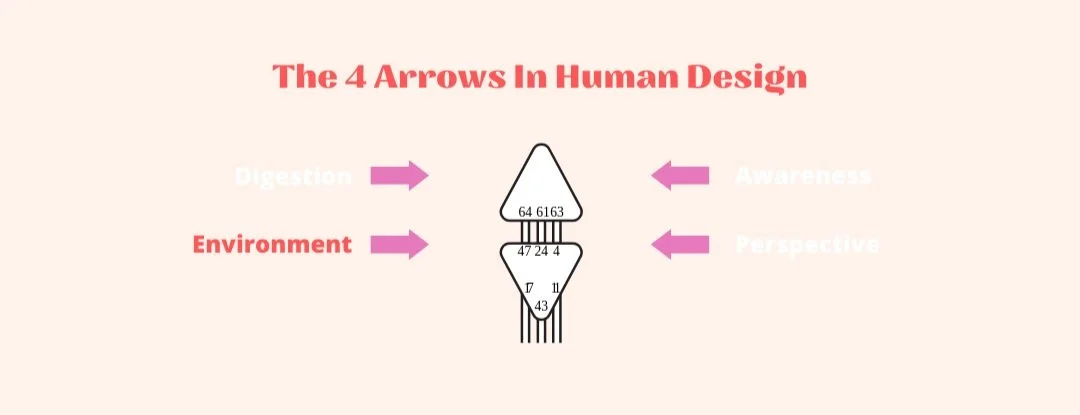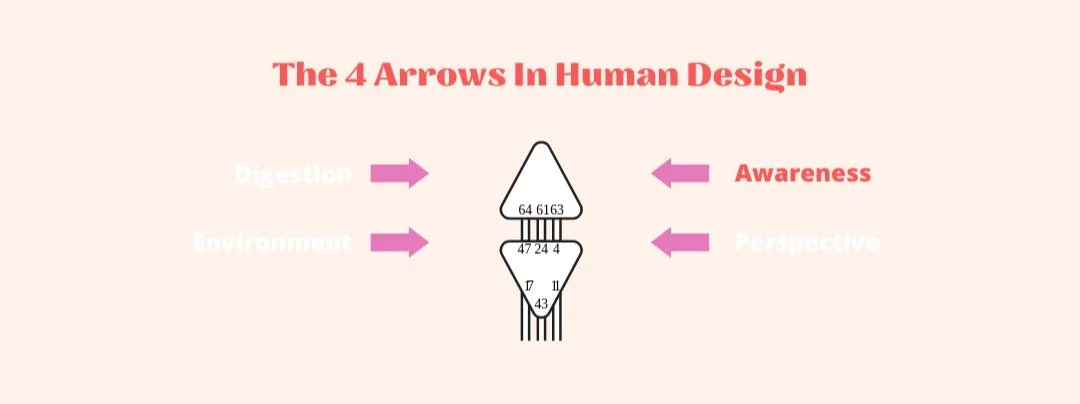How to Interpret and Apply the Arrows in Human Design
The first reaction a lot of people have to seeing their Human Design chart is to shut down and close their browser window cuz they have no idea what they’re looking at. I’m here to help make that not the case.
If you’re new to Human Design, I would recommend starting here - learning about what your Energy Type means at a high level and what your Authority is (how you approach decisions). These will be the most foundational elements of your chart and what you’ll likely utilize the most on a daily basis.
From there you get to have some fun diving into the different elements of your Design. I’ll admit that the Arrows in Human Design are something I’ve typically approached as more of a footnote. I tend to prioritize the other components, which leaves less space to discuss this part in an hour-long reading. While we do dive into this in my 1:1 coaching containers, it’s something I don’t cover much on social or the blog, but after having a hard time finding good resources to point people in the direction of on this topic, I decided to create one myself.
At the core of Human Design is the intent to get humans clear on using their natural operating systems and learn to operate in a way that utilizes their inherent gifts and removes conditioning and resistance from their daily tasks and ways of going about the world. And the Arrows are a super helpful puzzle piece for that.
Also called “The Variables” or “The Four Transformations,” the Arrows show us how we best approach routines, the environments we thrive in, how we best set and go after goals or our manifestations, and how we prefer to learn or take in information (kind of similar to our Profiles in that way). Below are the breakdowns of what it means for them to be Left vs. Right-facing in general, and then what that specifically means for each of the 4 Arrows on your chart (found at the top next to your Head Center). Ok, let’s get started.
Left vs. Right-Facing Arrows
The way the Arrows were initially taught to me and that helps me remember them is to think of the arrows pointing to the left being an “old paradigm” way of approaching life versus a new paradigm approach of the right-pointing arrows. Old paradigm here meaning a more structured, active, or even masculine way of approaching things, with a little more rigidity and preciseness.
The “new paradigm,” right-pointing arrows represent a more feminine, passive and fluid way of approaching things, with more variability and openness. Like all things in Human Design, neither of these are good or bad, or worse or better than the other. But awareness around where you’re coming from can be so helpful in optimizing the way you approach different parts of your daily life. Now let’s learn the difference between each direction for all of the four Arrows.
Top Left Arrow: Digestion
How we take in, or digest, the world around us, and how we set routines.
Left-Facing: Consistency and structure in your daily routines are helpful for you. You thrive with a predictable and consistent schedule, and feel freed up to take on the day when you know what to expect ahead of time. You’re also someone who probably can eat the same thing over and over and be totally ok with it. Lean in to creating schedules and routines for yourself, this is supportive for you. You’re also able to take in and absorb lots of information very well.
Right-Facing: A structured, predictable routine or schedule isn’t necessary for you. You can change things up on a daily basis, and allow for more fluidity in your schedule so you can approach things with a more go-with-the-flow attitude. You like to get creative with what you eat so let yourself try out lots of different things. You take in information in a broader, more generalized manner, so take your time with the way you learn and take things in to allow yourself to fully absorb it.
Bottom Left Arrow: Environment
How we prefer to exist in physical spaces and the consistency with which we approach disciplines or routines in our lives.
Left-Facing: You thrive in a consistent environment. It probably feels good for you to sleep, eat, and work in the same places every day. When you go somewhere new, you need time to really familiarize yourself with your surroundings and feel comfortable in them before moving on to something new. Allow yourself to enjoy the predictability of frequenting the same spots and sticking with what works, since this will likely feel best to you.
Right-Facing: You enjoy variety and flexibility with where you spend your time. It’s good for you to travel around and spend time in different environments, switching up where you work, and the way you do things on a daily basis. You can still have discipline in your daily schedules and routines, but don’t be too rigid with it. Allow movement and freedom for yourself, trying out different places and experiences to see what feels good for you.
Top Right Arrow: Awareness
How we learn, take in, and then recall information.
Left-Facing: Details, specifics, and getting granular with how you take in information is what works best for you. It’s good for you to dive in and really immerse yourself with the facts as this is how you best remember things, and then are able to quickly recall and share them with others too. Staying heads-down and focused on what’s in front of you is your go-to approach to learning.
Right-Facing: “Big-picture” learning is how you typically approach things. You look to zoom out and see things as a whole, and approach learning in a way that’s more fluid and free-flowing, not needing to get very detailed or rigid with the way you take in information. You have a gift for seeing the bigger picture and general themes that connect in a way that not everyone else can. Let go of the more traditional methods of education and learn things in a way that takes in all the angles and lets you create meaning and insight out of it.
Bottom Right Arrow: Perspective
How we set goals or approach manifesting things into our existence. The Specific vs. Non-Specific Manifestor Arrow.
Left-Facing: Specific Manifestor. Setting specific goals and laying out a detailed plan is your jam. Release any shame or judgment you might have for being INCREDIBLY SPECIFIC with what you want in life. Making plans and spelling out your goals and visions is how they come to you, so don’t be afraid of speaking your crystal clear intentions out into the Universe. Incorporating strategy and using business plans and specific goal-setting will likely be beneficial to you.
Right-Facing: Non-Specific Manifestor. The details of your goals or plans aren't as important to you. Instead it’s good for you to focus on the feeling behind achieving or receiving those goals. How do you want to feel in your career? Home? Daily life? Having a general idea of what you’re wanting is enough, you can release any pressure to come up with a detailed plan or roadmap of how you’ll get there, and know that just creating a general intention of what you want is enough!
Takeaways
As much as I think knowing about your Arrows can be helpful in the way you go about your life, I still look at these as kind of “the icing on the cake” of your Human Design knowledge. Everything should always be leading you towards more freedom in being your most authentic and ease-full self. So approach your Arrows in a way that allows you to free up any limitations or expectations you’ve put on yourself to act in a certain way - whether that’s how you go about structuring your day, approaching your business, or planning for your future - and always use Human Design in a way that makes you shine as bright as you truly are.
Want to learn what these look like for your life specifically? Book a 1:1 Human Design Reading with me here.











